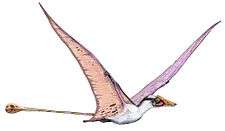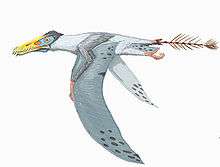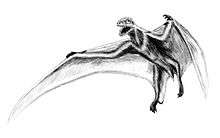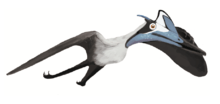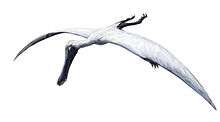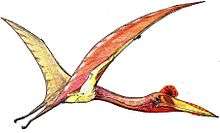Eudimorphodontidae
Eudimorphodontidae is an extinct family of early pterosaurs from the Late Triassic (early Norian to Rhaetian age) of Europe.[1][2] It was named by Peter Wellnhofer in 1978 to include Eudimorphodon ranzii. Some phylogenetic analyses suggested that Eudimorphodontidae is a junior synonym of Campylognathoididae,[3][4] however more comprehensive analyses found Eudimorphodontidae to be basal to Macronychoptera that includes Campylognathoididae and more derived pterosaurs (Breviquartossa).[5][6] Wang et al. (2009) found Eudimorphodontidae to include six species (the monospecific Peteinosaurus, Raeticodactylus and Caviramus, and three species of Eudimorphodon), but they didn't defined the clade.[5] Brian Andres (2010, in press) define Eudimorphodontidae and found Peteinosaurus to be most closely related to it. Furthermore, he found monophyletic Eudimorphodon clade (unlike Wang et al., 2009 and Dalla Vecchia, 2009), and defined two subfamilies within Eudimorphodontidae. The Eudimorphodontinae includes all taxa more closely related to Eudimorphodon ranzii than to Raeticodactylus filisurensis while the Raeticodactylinae includes all taxa more closely related to Raeticodactylus filisurensis than to Eudimorphodon ranzii.[6] More recently, Raeticodactylus and Caviramus were moved into their own family, Raeticodactylidae. The below cladogram follows that analysis.[7]
| Eopterosauria |
| ||||||||||||||||||||||||||||||||||||||||||
| Eudimorphodontids | |
|---|---|
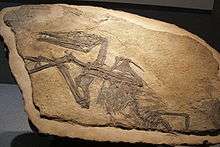 | |
| Eudimorphodon ranzii holotype (MCSNB 2888) in Milan | |
| Scientific classification | |
| Kingdom: | Animalia |
| Phylum: | Chordata |
| Order: | †Pterosauria |
| Superfamily: | †Eudimorphodontoidea |
| Family: | †Eudimorphodontidae Wellnhofer, 1978 |
| Type species | |
| †Eudimorphodon ranzii Zambelli, 1973 | |
| Subgroups | |
| |
References
- Barrett, P. M., Butler, R. J., Edwards, N. P., & Milner, A. R. (2008). Pterosaur distribution in time and space: an atlas. Zitteliana, 61-107.
- Richard J. Butler; Stephen L. Brusatte; Brian B. Andres; Roger B. J. Benson (2012). "How do geological sampling biases affect studies of morphological evolution in deep time? A case study of the Pterosauria (Reptilia: Archosauria)". Evolution. 66 (1): 147–162. doi:10.1111/j.1558-5646.2011.01415.x. PMID 22220871.
- Kellner, A. W. A., (2003): Pterosaur phylogeny and comments on the evolutionary history of the group. pp. 105-137. — in Buffetaut, E. & Mazin, J.-M., (eds.): Evolution and Palaeobiology of Pterosaurs. Geological Society of London, Special Publications 217, London, 1-347
- Dalla Vecchia, F.M. (2009). "Anatomy and systematics of the pterosaur Carniadactylus (gen. n.) rosenfeldi (Dalla Vecchia, 1995)." Rivista Italiana de Paleontologia e Stratigrafia, 115(2): 159-188.
- Wang X.; Kellner, A. W. A.; Jiang S.; Meng X. (2009). "An unusual long-tailed pterosaur with elongated neck from western Liaoning of China". Anais da Academia Brasileira de Ciências. 81 (4): 793–812. doi:10.1590/S0001-37652009000400016. PMID 19893903.
- Andres, Brian Blake (2010). Systematics of the Pterosauria. Yale University. p. 366. A preview that shows the cladogram without clade names
- Andres, B.B.; Clark, J.; Xu, X. (2014). "The Earliest Pterodactyloid and the Origin of the Group". Current Biology. 24 (9): 1011–6. doi:10.1016/j.cub.2014.03.030. PMID 24768054.
